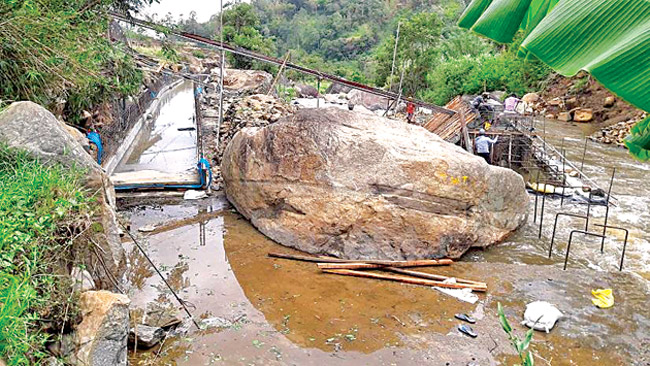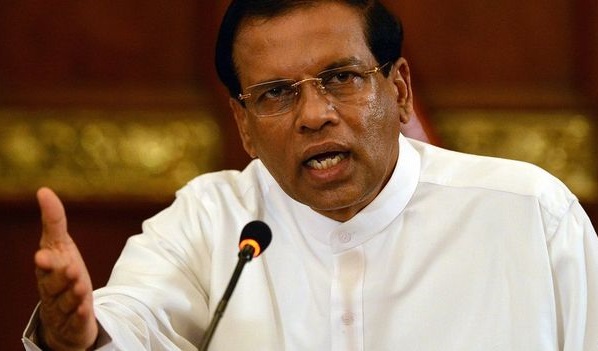
Construction and forest clearing in Wilpattu National Park violates conservation laws
WNPS expresses deep concern
The Fauna and Flora Protection Ordinance No 2 of 1937 (as amended, hereinafter at times referred to as the FFPO) which governs the legal administration of the Protected Areas of Sri Lanka clearly states that there can be no development activity or clearing of the habitat within National Parks (Section 6).
According to information available, the Pallenkandal Shrine was built over 300 years ago in what is now the Wilpattu National Park. It was a small chapel placed in an area of less than a quarter of an acre, and was used in an annual feast for fishing communities who reside around the Puttalam Lagoon.
They visited the shrine for two nights a year and stayed in temporary shelters until the festival was over. These shelters were then dismantled at the end of the feast.
During the war, this chapel went into disuse, and the building fell into disrepair, with the roof caving in. Since the end of the war, however, not only has the shrine been rebuilt to greater size than the original, but additional structures have now been added with clearing being made beyond the original boundaries of the shrine.
These are areas previously used by herds of elephants who traditionally graze on the grasslands of the Pomparippu Plain within the National Park, and have done so for thousands of years.
The Wilpattu National Park comprises five Blocks which have been gazetted at various times from 1938 to 1973 under the FFPO. Upon such protection status being given, by operation of Law, all private tenements, rights and privileges seized to be operational over the said land, unless otherwise recognized by Law as a ‘traditional practice/use’ subject to Section 3 (a & b) and 4 of the FFPO inter alia.
They have, however, no right to expand the boundaries of the original site, or to change what was traditionally an annual event to a weekly/monthly feast, as happens now.
The Wildlife & Nature Protection Society (WNPS) is greatly concerned that this blatant breach of the laws of the country are taking place with the Department of Wildlife Conservation (DWC), the statutory guardian of the protected areas, taking no action to stop this illegal development taking place within the boundaries of a National Park.
It is the WNPS’s position that the construction and forest clearing undertaken by the St. Anthony’s Church at Pallenkandal, in the recent past, are inside the Wilpattu National Park and being carried out without resorting to the proper Law and procedure. The construction/renovation and clearing of forest land conducted by and/or on behalf of the said church are in violation of the Law of the Land i.e. Sections 6 (1) of the FFPO No 2 of 1937 (as amended).
In addition, the detrimental impact on the National Park caused by the uncontrolled and/or unregulated human intrusion by thousands of pilgrims who visit the church on a weekly/ monthly/annual basis cannot be ignored, and amount to an offence under the Sections 5, 5 (A), 5 (B) & 6 (1) of the FFPO.
Even to claim any right under ‘traditional use’, a claim which the WNPS does not concede to, the applicable provisions of the FFPO are quite clear that such a right should be exercised subject to the control and supervision of the DWC, as the Custodian of the Wilpattu National Park, who hold it in trust for and on behalf of the people of the Republic.
As such, there is a grave failure on the part of the DWC to uphold their mandate and effectively enforce the law within the boundaries of the Wilpattu National Park.
Rukshan Jayewardene, President of WNPS, said: “National Parks are declared because a nation values and intends to protect its Fauna and Flora that forms an integral part of its natural heritage. National Parks afford the greatest level of statutory protection for wilderness, while also providing for regulated public access.
“Governments hold these lands in trust for all citizens and special interest groups cannot be allowed to violate the integrity of such Protected Areas”.
The WNPS, at 122 years old, is the oldest Non-Governmental Organization in South Asia. It was responsible for setting up and administering the National Parks, and inaugurating the Department of Wildlife Conservation.
With such history and responsibility, the Society is determined to take whatever action is necessary to prevent a precedent being set that will have serious consequences to the future well-being of all of the protected areas of Sri Lanka. Their preservation is vital not just for environmental, cultural and aesthetic reasons, but also for the economic prosperity of this country, and for the benefit of future generations to come. (WNPS Press Release).
Source: The Island http://island.lk/index.php?page_cat=article-details&page=article-details&code_title=150677

Call to protect environment from mini-hydro power projects
Rainforest protectors in Sri Lanka requested the authorities to take immediate corrective steps to stop the destruction taking place due to the rapidly spreading mini-hydro power projects throughout the wet zone. They urged that the national policy on renewable energy be focused on technologies that do not cause ecological destruction to catchment areas.
According to rainforest protectors, water sources, including main streams around Mandaram Nuwara and Hanguranketha have became the latest victims of the rapidly spreading mini-hydro projects. They have became a threat to the livelihoods of the people in these areas.
Agriculture is the main livelihood of the people in the Hanguranketha, Walapane, Delthota and Pathahewaheta Divisional Secretariat Divisions. They are fulfilling their water requirement mainly from Belihul Oya, Ma Oya, Thalathu Oya and Marassana Oya. These areas have faced a huge threat with the commence of the construction of new mini-hydro power plants.
Social, economical and environmental issues are rising up with the construction of the Deegalhinna mini-hydro project based on Deegal Oya. More than 300 acres of paddy fields around one kilometre of Deegal Oya have gone dry due to the obstruction of water supply. New hydro projects have caused the drying of Ethawatunuwala waterfall and Deegalahinna waterfall by threatening endemic plants and animals.
Source : Daily News 30/07/2016 http://www.dailynews.lk/?q=2016/07/30/local/89011

President Sirsena pledges to take strict action against environmental destruction
President Maithripala Sirisena while addressing an event held in Polonnaruwa today, stated that if any environmental harm is reported in a certain area, strict action will be taken against the responsible government official in the area.
The event was held at the Sevamuktha Kandavura Maha Vidyalaya in Polonnaruwa this morning to declare the National Environment Week, parallel to World Environment Day which falls on the 5th of June.
President Sirisena planted a Na sapling at the school premises to mark the Tree Planting Programe implemented in line with the National Environment Week. Gold medals were awarded for the Environmental Pioneer Brigade in the Dimbulagala area under the auspices of the President.
The President in his address pointed out that the Kelani River basin in the Colombo District lies completely destroyed today and around 150 meters on either side of the banks of the Kelani River are full of constructions and all reserves which belong to this river are destroyed.
He further added that buildings have been constructed over the canals, drains and waterways in Colombo and especially Kolonnawa and it is the politicians, state officials and everyone of their respective eras who should be held responsible for this and if any unauthorized buildings or environmental pollution happens in a way which damages the canal and river preservation in any area, strict action will be taken against the responsible government officials in these areas.
(Source : 30-05-2016: News First (Sri Lanka http://newsfirst.lk/english/2016/05/president-sirsena-pledges-take-strict-action-environmental-destruction/137861)





